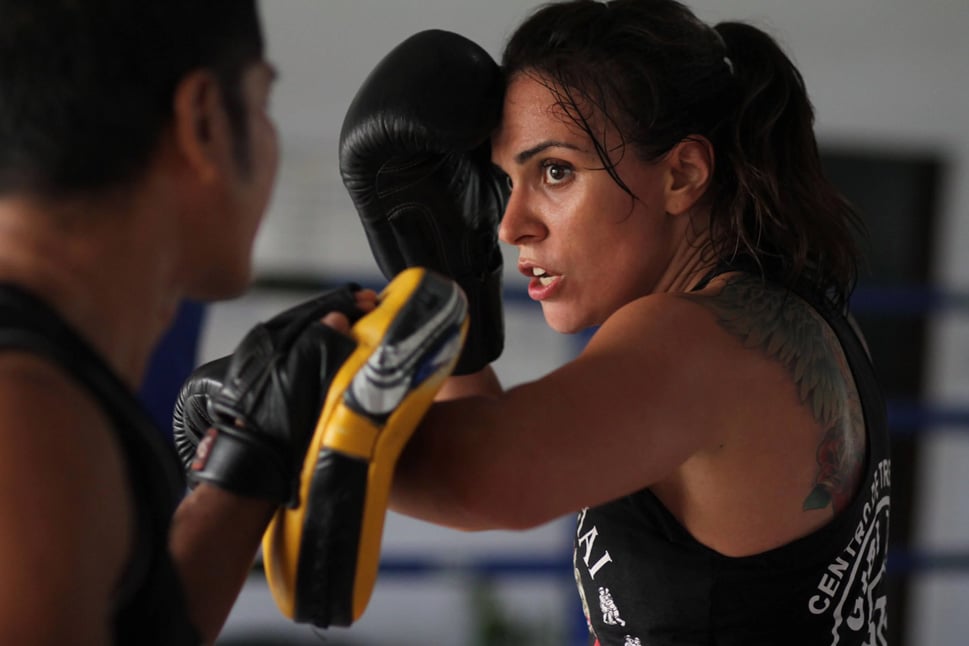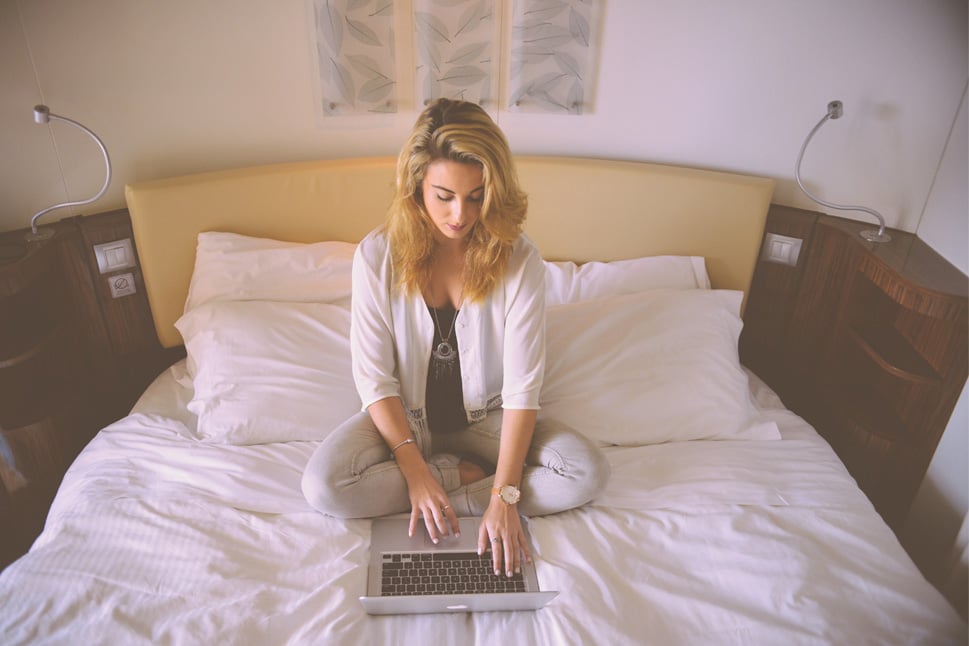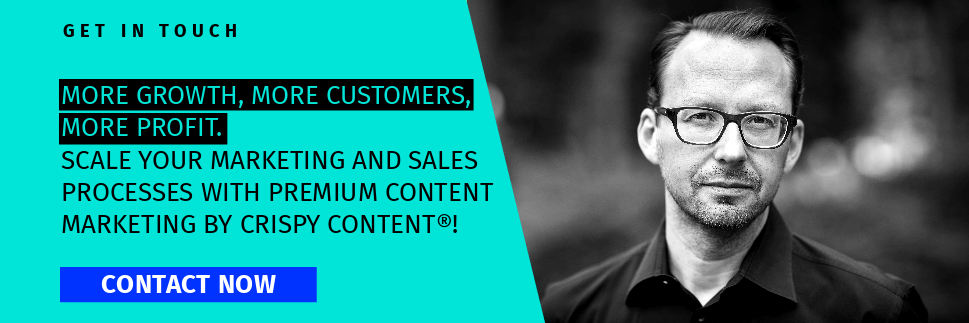The Content Audit - Part 2
Last updated on January 2, 2023 at 12:38 PM.In the world of digital audits, the SEO audit steals all the spotlight. But successful SEO goes hand in hand with successful content - one cannot exist without the other. A content audit makes sure that the content you put out there fits the needs of your customer; making them a regular visitor or regular paying customer. In the second part of our two-part series, we show you our 4-step roadmap of our content audit.

Step 1: Defining the Goal
A content audit is a major, almost philosophical challenge. In a sense, this is where we ask ourselves the big questions of entrepreneurial life: who am I, what makes me and my offering tick, and where do I want to go? The more clearly we formulate our goals in a content audit, the more concretely we can evaluate our content. Our goals can be quantified through metrics, but we need to interpret the values qualitatively.
We start by defining our business goals. How do we want to earn money in the future? What content, topics, or search terms best describe our offering to our future target audience? How does success show up in our analysis tools? How do we recognize failure?
Since winning a customer is always a development process, we start at the top of funnel.
Goal 1: Improve our Visibility in the Search Engine
Every offer ranking on a search term in the search engine is nothing more than a place in the window display of the largest department store in the world (next to Amazon). If our offer is visible in the organic search engine results, we are doubly fortunate. On the one hand we have convinced Google's artificial intelligence that we have described our offer excellently, on the other hand Google rewards us with free visibility. Not every visitor to our offer is gained via the search engines and not every text is intended for the search engine. Let's think about an abstract Dadaist poem: it is hardly indexed on Google, nor does it correspond to keywords with a relevant search volume. But if it is read on the author's website, it could result in the author's booking for a reading tour and create an economic effect.
If we evaluate our content from an SEO point of view, the search engine should also be a valid attribution channel.
Goal 2: Increase the Interaction of our Target Group with our Offer
Using data from Google Search Console and our analytics tools (Google Analytics, Piwik, Adobe Site Catalyst, etc.), we can find out which offers are of most interest to our anonymous users. Typical metrics include page views, visitor counts, dwell time, bounce rate, the length of a user's path to our offer, or even the achievement of a conversion goal, such as visiting a particular subpage.
These metrics quantify an engagement with the topic presented and represent part of the user's customer journey.
Goal 3: Improve Conversion Rates
According to our conversion funnel, the user's behavior changes and so does his role. Before he, the anonymous visitor, becomes a paying customer, he must identify himself as a potential customer. Most often, this happens by registering via email or by entering a phone number - a form submission or data transfer. Form submissions and page visits correspond with each other. Each form submission is preceded by a page visit, each page visit by a click on a search engine result, a link in an email or an advertising banner. The higher the percentage of form submissions per visitor, the higher the conversion rate. The basic data for calculating conversion rates usually comes from various technical solutions, which are either evaluated in a consolidated form in a technical solution such as HubSpot or calculated in Excel.
After determining which areas of the funnel we want to take action on, we identify the metrics we can use to determine the status quo. These generally fall into four categories:
- SEO metrics, such as organic traffic, backlinks or keyword rankings
- Behavioral metrics, such as page views, average dwell time or bounce rates
- Engagement metrics, such as likes, shares, comments, or mentions
- Sales metrics, such as number of leads, conversions, ROI, etc.
Which specific metrics matter to us, depends on what reasoning we want to use them to support.
Step 2: The Inventory
Content audits begin with an inventory of all content available for search engine indexing. This is not because we just want to optimize visibility, but because the search engine is cataloging our content. This content is then analyzed against a variety of metrics to be transformed into one of three actions: Keep, Improve or Remove.
Which data we use for inventory is entirely up to us. In most cases, we have more data than we can handle. The above tool provides information on the following metrics:
Page Title, HTTP Status Code, Click depth, Links To Page, Links From Page, Word count, Cache date in Google, Link Value, Page Authority, InLink Rank, Page Bounce Rate (GA), Pageviews (GA), CSS Validation Errors, HTML Validation Errors, Frames, Conflicting Character Encoding, Broken Links, Nofollow External Links, Nofollow Internal Links, Nofollow links, External links, Internal Links, Image Count, Images With Empty Alt Text, Broken Images, H2-H6 Count, H1 Count, Meta Keywords Length, Meta Keywords, Multiple Meta Description Tag, Meta Description Length, Meta Description, Multiple Title Tag, Title Length, Assigned keywords, Optimization rate, Multiple rel="canonical" URLs, Canonical URL, Redirect URL, Robots Instructions, Last Modified and Page size.
This "more" information does not help us to judge which content is relevant and which is not, but it helps us to get the most out of the content we focus on.
We collect the results of our crawl in an Excel spreadsheet where we can structure the data as we see fit.
Step 3: The Analysis
Once we have exported the data, we need to interpret it for our purposes. We use quantitative data to evaluate it qualitatively. To do this, we need to relate the information to the goals we have formulated.
The biggest challenge is the third column. This is where we record what we want to do with our existing pages. Whether we keep a page or invest in it and improve the content on it is not so much a content decision as a commercial and strategic one.
Qualitative and Quantitative Analysis
Content can be described qualitatively and quantitatively. From a quantitative point of view, a content consists of various content elements that are described by text in a certain number of characters. The characters convey information to the search engine crawler, which is matched with the user's search query. One might assume that the more information we provide to the crawler, the better. However, the search engine does not want to provide the searcher with all the information, but only the correct information. Correct information is characterized by the fact that the user shows behaviors that indicate a positive evaluation, e.g. a long dwell time, a click on a link that leads him deeper into the website, etc.
The reason for this behavior lies in the quality of the content. The quality of the content can be described by the approach, the visual language, the use of keywords or the thematic focus.
However, there is another aspect to this: the search engine is merely an attribution channel for access to a website. Users can also come to us via a brand mention in a third-party publication. We could also run ads that link to our landing page. In addition, search engines have a problem with innovation: What if we want to launch a product that has never existed before, users don't know about it, and accordingly don't search for it?

In step four we delete or revise existing content
Step 4: The Revision
A revision has a cost-benefit ratio. If our content works well and remains relevant to us in terms of content, we don't need to optimize it.
If our content does not work, then we have to decide between a revision or a deletion of a page. The revision can be caused by changes in search engine algorithms, user search behavior, our business offer, or other external circumstances.
If the revision is too costly and the content is no longer justifiable in its current form, we must delete the page. However, deleting a page does not mean deleting content: if the content is significant, just not its current form, the content could be absorbed into another page as an enriching element, if necessary.
There is no standardized procedure for editing the content; it results from the deficiencies that become apparent during the analysis. Basically, the following applies: only when we have formulated ourselves and our offer in a clear-cut way can we think about how to prepare it for the various distribution channels and the different target groups. First position, then market.
The following actions are part of the revision process, but they don't always have to be done:
- Reuse of existing content in other contexts or formats.
- Revision of content with regard to statements made
- Technical restructuring of content
- Updating using new statistics, trends, or product details
- Revision of calls-to-action for conversion rate optimization
- Enrichment with videos
- Enrichment with images
- Metadata optimization
- Internal linking optimization
- SEO troubleshooting
- Technical troubleshooting
- Re-indexing via Search Console
All the actions we take need to be documented in a reporting. The reason is simple: everything is in motion, our knowledge and views, our competition, search engine algorithms, the needs of our target audience, etc. What seems to make sense to us today, might not make sense tomorrow. Since there is a logic behind each of our decisions, we should keep them for later reflection.
Summary
How you rank in the search engine is only part of your (future) success: the quality of your content needs to turn a potential customer into a paying one. We hope that after reading our two-part mini-series you have a deep understanding on how important it can be to separate the useful content from the clutter on your website, making sure your website ranks higher and the content is more fitting to what your user is looking for.
 Gerrit Grunert
Gerrit Grunert
Gerrit Grunert is the founder and CEO of Crispy Content®. In 2019, he published his book "Methodical Content Marketing" published by Springer Gabler, as well as the series of online courses "Making Content." In his free time, Gerrit is a passionate guitar collector, likes reading books by Stefan Zweig, and listening to music from the day before yesterday.
More topics you might like

Is the B2B Buying Cycle Really More Complex?
Discover why the fundamental B2B buying process remains unchanged despite new digital touchpoints, and how to leverage this for effective strategies.

How to Make Technical Content Work for Decision-Makers
Transform complex technical content into engaging, strategic insights that resonate with decision-makers in industrial, tech, and B2B sectors.

Maximizing ROI from Thought Leadership Content
Learn how to turn thought leadership content into a measurable business asset that drives trust, engagement, and conversions.

Top 5 Criteria for Choosing the Right Content in B2B Marketi...
Discover the 5 key criteria for selecting the right B2B content formats. Learn how to tailor your strategy to personas, touchpoints, and goals.

AI and Cultural Expertise for Your Marketing Organization
This post explains why the right mix of technology and cultural know-how is indispensable when utilizing Artificial Intelligence.

AI Tools For Content Creator
Explore Crispy Content's AI integration strategy that enhances content creation while preserving human creativity and control.

How Our Content Marketing Strategies Drive Brand Awareness, ...
Discover how our content marketing strategies drive brand awareness, boost traffic, generate leads, and improve sales outcomes.

Master the Art of Content Strategy for Business Success
Unlock the secrets to developing a content strategy that aligns with your goals, addresses audience needs, and elevates your brand authority.

Webinar: Building An AI Content Machine
Discover how AI transforms content production strategies. Register for our free webinar with AI experts Gerrit Grunert and Jens Palm on November 28th!

How Pharmaceutical Companies Optimize Their Marketing with A...
Discover in our latest blog how pharmaceutical companies can optimize their marketing retainer with the help of AI.

Webinar: Building An AI Marketing Machine
Explore the transformative power of AI in B2B marketing with our webinar "Building an AI Marketing Machine" in cooperation with Salesforce and factory42!

Mastering LinkedIn's Labyrinth: Unveiling Algorithm Secrets
Unlock LinkedIn's potential with our guide. Discover algorithm secrets, optimize content strategy, and learn about future trends.

Revolutionizing Content Creation: The 6 Best AI Tools for Wr...
Discover out top 6 AI tools transforming content creation. Enhance your writing process and quality with AI technology – don't miss this opportunity!

Unleashing the Power of Ecommerce SEO
Unleash the Power of Ecommerce SEO: Fix broken links, optimize content, dominate Google rankings, and attract eager customers.

B2B Lead Generation with White Papers
Lead generation with white papers is one of the most effective sales measures in B2B business. Why? We explain that in this article!

The Content Audit - Part 2
In part two of our mini-series, we explain our 4-step road map to our successful content audit resulting in higher rankings in search engines.

The Content Audit - Part 1
In this article we show you just how important a content audit is, how SEO cannot live without good content, and why you need to check in regularly.

The Paid Media Audit - Part 2
In second article of our mini series we show you how to audit your paid media in seven thorough steps.

The Paid Media Audit - Part 1
In this article we take a look at how paid advertisement works, the different approaches of a Paid Media Audit, and which tools can help you up your game.

The CRM Audit - Part 2
In the second part of this mini-series, we'll show you how to perform a CRM audit and get more ROI from your data in seven easy steps.

The CRM Audit - Part 1
In the first part of this mini-series we explain what a CRM audit is, what the benefits are, and which tools to use.

The benefits of a successful pitch-workshop
Our idea of a good workshop consists of six outcomes that must be achieved at the end of a succesful pitch workshop. Discover them here.

Why regular agency pitches don’t work
11 reasons why agency pitches fail to do what they’re designed to do: to choose the right agency for the job – and our proven solution for it.

How to host a perfect pitch-workshop
A workshop instead of a standard pitch? In this article, we explain how to host a perfect pitch-workshop and show the benefits.

SEO For Pharma Companies: Why There is No Way Around It
Pharmaceutical companies, whose products are so in need of explanation and demand, cannot do without SEO. We show why this is so.

HubSpot History: What Made HubSpot a Success
The history of HubSpot shows how it became one of the most popular and demanded marketing software to date. Let's dive into it!

Content-Marketing For Pharma Companies
Nowadays, no pharmaceutical company can afford not to communicate with its target group. In our article, we show why this is the case.

Crispy Content® is looking for a Senior Content Team
Crispy Content® is looking for a Senior Content Strategist (m/f/d) and a Senior Project Manager (m/f/d).

Decoded: Content Marketing and SEO with Brian Dean - Part 2
The best hacks from SEO genius Brian Dean: Learn which strategies you can use to improve your ranking and create gripping online videos.

Decoded: Content Marketing and SEO with Brian Dean – Part 1
The best hacks from SEO genius Brian Dean: Learn which strategies work best for content marketing, PR and landing pages.

TikTok Marketing: 6 Reasons B2B Brands Should Use It
TikTok is one of the quickest growing social media platforms at the moment. We show you 6 reasons why B2B brands should use it too.

Decoded: Content Marketing with Gary Vaynerchuk – Part 2
Learning from the "Content God" - Part 2: Learn from GaryVee which social media strategies will make you successful in 2021.

Decoded: Content Marketing with Gary Vaynerchuk – Part 1
Learn from the "Content God": Find out how GaryVee reaches millions of fans with micro-content, storytelling and an authentic brand - part 2 follows.

An Entrepreneur's Guide to Social Media Management Software
Still wondering what sets social media pros apart from the rest? Social media management software they pay for. We list the ones that are worth to pay for.

Email Marketing with Noah Kagan - Part 2
Do you want to generate leads and more sales through effective email marketing? Discover tips 6 to 8 from online marketing expert Noah Kagan.

Email Marketing with Noah Kagan - Part 1
Want more leads and sales through effective email marketing? Discover the first 5 tips from online marketing expert Noah Kagan - part 2 follows.

The Customer Journey
In "Content Marketing 101" Crispy Content® highlights the most important topics in Content Marketing – here we focus on the customer journey.

The Conversion Funnel
In "Content Marketing 101" Crispy Content® highlights the most important topics in Content Marketing – here we focus on the conversion funnel.

The 7 Steps SEO Audit
In this article, content marketing expert Gerrit Grunert from Crispy Content® shows how anyone can perform an SEO audit in 7 steps.

Content Marketing Decoded: Social Media Examiner – Part 2
You want to improve your performance on Facebook, Instagram, LinkedIn and TikTok? Discover 6 practical tips from Social Media Examiner Michael Stelzner.

Successful Blogging: 14 Effective Example – Part 2
Blog success factors, blog millionaires and your next steps - all this in the second part of our little series on "Successful Blogging".

Successful Blogging: 14 Effective Example – Part 1
We have collected 14 blog examples that have been successful over the last six years. And we have investigated why this is so. Here comes part 1!

Content Marketing Decoded: Social Media Examiner – Part 1
Looking for ideas for your marketing on Facebook, Instagram, LinkedIn and TikTok? Discover 7 practical tips from Social Media Examiner Michael Stelzner.

Content Marketing Decoded: The SEO Hacks of Neil Patel
You want to improve the search engine ranking of your website? In our series we present the most important SEO tips from digital expert Neil Patel.

FREE Online Course: “Making Content” (7 Lessons)
An online course with 7 lessons to produce high-quality digital content – quickly, easily and affordably.

10 Steps For Your Perfect Website Content Strategy – Pt. 2
A guide for content marketers who want to develop a website content strategy. The second part deals with features, structures, keywords and governance.

10 Steps For Your Perfect Website Content Strategy – Pt. 1
A two-part guide for content marketers relaunching a website. The first part deals with goals, target groups, positioning, topics and formats.

15 Content Tools We Still Use | Part 2
We present the tools we use at Crispy Content® to realize content production. Today: Content Production and Content Distribution.

15 Content Tools We Still Use | Part 1
We present the tools we use at Crispy Content® to realize content production. Today: Content Discovery and Content Planning.

Post COVID-19: Reasons Germany will be Your Next Best Market
There will be a future after COVID-19 - and it probably looks more promising in Germany than in most countries of the world. We show you why!

How to Do Content Production for Blogs with Airtable
In this detailed overview, we explain how complex content production projects can be completed with Airtable.

"Car dealerships need social media marketing"
The car industry has been severely affected by the corona crisis. Gerrit gives tips on how the crisis can be used as an opportunity with social media.

Content Marketing Agency - 10 Lessons Across 10 Years
With our ten lessons from ten years as a content marketing agency you can save time, money and stress by reading this now!

Gerrit Grunert: A HubSpot Interview with CIO Applications
What does an international company have to consider when choosing a German HubSpot partner? Gerrit Grunert reveals this in an interview. Read it now!

SEO in Real Life
Here we explain how Google works with a small, real-life theater game from our SEO workshop. Learn more here!

How To Create A Persona
Why are personas important for content marketing? How many do you need? Read about this and more in Gerrit's new book "Methodical Content Marketing".

The digital transformation of the PR Agency
How can PR agencies embrace the digital? This article by Crispy Content® reveals how PR agencies can master digital transformation in 4 easy steps.

An Interview with Sandra Harzer-Kux from Territory
Sandra Harzer-Kux, Managing Director of Germany's leading brand content agency, Territory, in an interview with Gerrit Grunert.

Campaign Management 101: Campaign Layering
Ever wondered how you can convey brand values in a more creative way across multiple platforms? This blog provides an intro campaign layering.

Methodical Content Marketing: Persona Pt. 1
What advantages does persona development have for both sales and marketing teams? What can they add to content marketing? Read more about this works.

Reputation Marketing and ROI
Reputation management has ROI? Yes! And it should be considered reputation marketing instead! How does this work? Read more in this blog to find out!

How Much Does A Content Marketing Strategy Cost?
How much does a content marketing strategy cost? Which aspects go into developing a strategy? The content experts at Crispy Content® break this down.

Mo' Money, No Problems – from Searchmetrics Summit 2017
How you can use an optimized customer journey to win over customers and many other topics in our Live Show from Searchmetrics Summit 2017!

Marketing Automation – From Persona to Personalization
Buyer personas are important, but how should you get your message across to individual users? Personalization is the key.

Checklist: Competitiveness Analysis in Content Marketing
Only those with an eye on the competitiveness can position their content marketing strategy successfully. Here’s a handy checklist.

Return On Content Marketing Investment
You’ve invested in a content marketing strategy – but has it been worth it? We show you how to calculate the ROI for your content marketing.

Conversion Optimisation in Content Marketing
In this blog post, we show you how to optimise your conversion rate within your lead generation activities.

Content Marketing: From Strategy to Campaign and Back Again
Campaigns are the beating heart of a content marketing strategy, not merely the icing on the cake. Here’s a recipe to try “at home”.

How to Find the Right Content Marketing Agency
Finding the right content marketing agency can be tricky. These are our insider tips:

Predictive Lead Scoring – A Glimpse Into the Future
Predictive lead scoring builds on traditional methods, but exploits the possibilities of modern technology much more effectively. We show, how it's done!

Big Data in Content Marketing
Here, you can learn why big data is so important to your marketing activities and how your company can best process user-generated data masses.

How to Create a Content Marketing Strategy
Those wishing to invest in content marketing require a tailored strategy. In six easy stages, we show you how to get one.

Lead Scoring: The Highest Form of B2B Marketing
We show you how to use lead scoring to evaluate potential customers more effectively and bridge the gap between marketing and sales.

Next Level Lead Nurturing
Turning leads into customers requires a care, time and a suitable strategy. Lead nurturing accelerates this process significantly.

Outstrip Your E-Commerce Competition
How can online retailers steer the purchase decisions of potential customers – in all phases of the buyer's journey?

The 3 Biggest Content Marketing Pitfalls
Bad content marketing is often marked by the same recurring errors – three of which are particularly severe.

Storytelling: Why the Brain loves Stories
Storytelling and mirror neurons? We explain how to use neuroscientific research to tell stories that will delight your customers.

7 Email Marketing Trends You Should Know
Those who allow email marketing trends to pass them by will soon be watching the competition do the same. It's essential to keep these 7 points in mind.

Conventional Marketing Doesn't Work On Millennials
Millennials have announced it loud and clear: content marketing is the best way for marketers to reach their goals.

Why insurance companies should practice content marketing
How do insurance companies integrate content marketing into their marketing strategy?

Content Marketing For Financial Services Providers
How important is content marketing to companies that deal with insurance, investment and financing and which strategies do they pursue?

Off-page analysis: Quality & quantity keywords
We’ll show you which SEO data is important for your keyword strategy and how you can benefit from your competitors’ success.

5 reasons hotel chains should practice content marketing
The Crispy Content Sector Review shows that hotel groups are still neglecting content marketing.

Six building blocks for successful localisation
We have created a checklist of the six building blocks of a high quality full service localisation.

4 reasons tour operators should practice content marketing
In our Crispy Content Sector Review we examine what companies within a specific sector can achieve with content marketing.

7 easy steps to the perfect long tail keyword
How can you improve your ranking efficiently and sustainably without spending money on it? We’ll show you how!

Storytelling competence: How to spot marketing talents
How can you even tell if an agency or freelancer can offer the required storytelling potential? We have compiled the key indicators for you!

Content Marketing on Instagram: 5 successful examples
We’ll show you how to realise your brand’s content marketing strategy using Instagram.

Content Marketing: 9 tips for a successful blog promotion
Networking, Social Media Marketing and Reposting: That's how you seed your Blog Content!

Your successful content marketing cycle in 6 steps
These 6 steps will help you develop your very own content marketing cycle.
![[FREE Ebook] Content Marketing Tools Essentials](https://no-cache.hubspot.com/cta/default/463294/02a763e7-df79-4758-ba35-000e19399736.png)

